On Sunday, June 29th, the Gakumachi Collaboration Project “Public Presentation Screening (Second Screening)” was held.The “Gakumachi Collaboration Project” is a project that grants support funds to initiatives in collaboration between the university and the local community to create attractive communities and solve local issues.
In the presentations on the day, 21 organizations that passed the first screening gave presentations on their planned projects from the students’ perspectives.
As a result of the screening, 16 projects (one of which is an incentive project) were selected as support projects, and at the certification ceremony held at Kyoto City Hall on Wednesday, July 9, Mayor Kadokawa presented certificates to the representatives of each project. Representatives of each organization that has been certified as a support project have expressed their determination to implement the project, and it is expected that support projects in collaboration with student organizations and local communities will be developed in various parts of Kyoto City in the future.
We have announced our business plan, which we have worked so hard to develop! There was also an appeal in kimono …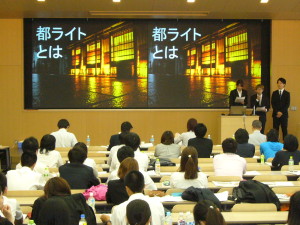
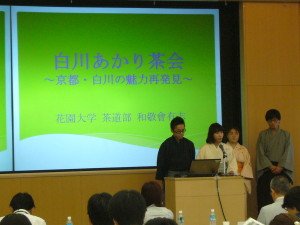
We will also answer sharp questions from the judges! Finally, a comment from the Director of the Policy Division of Kyoto City University!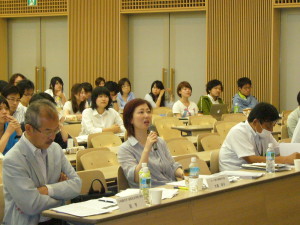
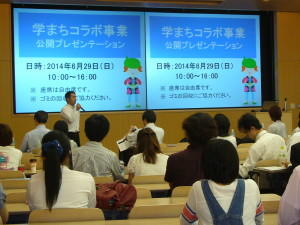
Certification ceremony
Awarded a certificate by the Mayor of Kyoto, Kadokawa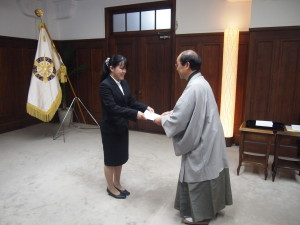
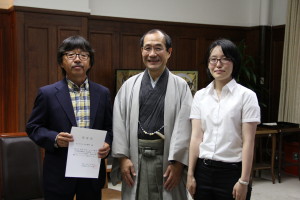
It was a tense declaration of determination!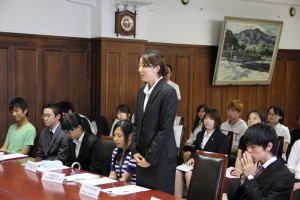
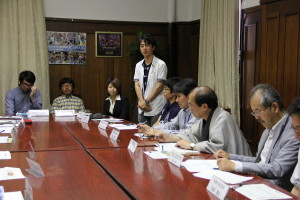
We will do our best to revitalize the region!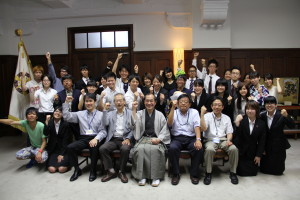
【Supported Projects】15 Projects
| Project Name [Amount of Support] Organization | Name [Name of Affiliated University / Activity Administrative Region] Project | Overview |
|---|---|---|
| Fushimi Fukakusa Community Archives [300,000 yen] |
Fushimi and Fukakusa Community Archive Project [Ryukoku University/Fushimi Ward] |
The movement to archive local “records” and “memories” as intellectual property is gaining momentum throughout the country. In Fushimi Ward, there is a strong momentum for this movement, and there is a particularly strong interest in the townscape and life of the Showa era. The purpose of this project is to collect, digitize, and publish materials (8mm film that is deteriorating) that record the townscape and lifestyle of the Showa era from the perspective of ordinary people, and to consider how to use them. |
| Otomodachi Strategy! ~Music Workshop from 0 years old~ [109,100 yen] |
Nico Nico Family Concert Executive Committee of Kyoto City University of the Arts Student Volunteers [Kyoto City University of Arts / Shimogyo-ku] |
Friendly House Nishihachijo in Shimogyo Ward is an educational facility for children aged 0~3 years old and their parents. Parents and children with small children tend to be isolated from society for a variety of reasons. By creating a space where such parents and children can gather, this facility aims to ease the burden of child-rearing and create a better child-rearing environment. We would like to continue to hold music workshops for parents and children there, and create a place where parents can relax and connect. |
| Operation Umezu School District ~Connecting residents with towns, towns and school districts [300,000 yen] |
Federation of Umezu Neighborhood Associations (in charge: Umezu Town Development Committee) + Ritsumeikan University Inui Seminar [Ritsumeikan University / Ukyo Ward] |
(1) To convey the appeal of the Umezu School District’s community activities to those who have newly moved to the area and those who have not joined the residents’ association, and to disseminate the contact point for the community (Preparation and distribution of “(tentative) Umezu Regional Activities Chronicle” and “Umezu Regional Activities and Regional Organization Navi”). (2) At the same time, create opportunities for new people to meet each other in the town and create an atmosphere where it is easy to participate in local activities ((tentative) Welcome to Umezu / Welcome to XX Town). (3) In response to the above activities, we will more actively develop events that are easy for new residents to participate in and want to participate in. |
| Discovering the region’s attractive living and cultural spaces× Chanoyu Hospitality Promotion Project [300,000 yen] |
Hanazono University Tea Ceremony Club Volunteer 【Hanazono University/Higashiyama Ward】 |
(1) Students working on the tea ceremony will work with local residents to discover the history of the region and the lifestyle and culture of people who live in harmony with nature. (2) Consider a tea ceremony that enhances the charm of the place you discovered, and provide a tea ceremony as a space for local hospitality. (3) Create a poster that combines the discovered place and the tea ceremony, and disseminate it in the form of a poster and a booklet summarizing it as a hidden cultural space in the region. |
| Arashiyama Art Project [300,000 yen] |
Kyoto Saga University of the Arts, Faculty of Arts, Department of Design, Department of Tourism Design [Kyoto Saga University of the Arts/Ukyo Ward] |
Utilizing the facilities at Arashiden Arashiyama Station, which is the center of Arashiyama, we will exhibit art works unique to the University of the Arts and develop a project to turn the station into a museum. It expresses that Arashiyama, Kyoto, is not only a place of tradition and history, but also a place that nurtures cutting-edge culture and art. We hope that the students’ works, such as paintings, prints, sculptures, and dyeing, will transform the station into an art space, and in the future, it will be an opportunity for art to spread from the station to the community. |
| Keihoku Utsu Fureai Learning Mutual [300,000 yen] |
Kyoto Seika University Keihoku Utsu Treasure Search Club [Kyoto Seika University / Ukyo Ward] |
The purpose of this project is to revitalize the Uzu area and foster rich learning for students. The Uzu area is blessed with abundant nature and history, but depopulation is progressing. We will present scenarios for regional revitalization through exchange and learning, focusing on 1) searching for local treasures (interviews on local culture, history, and lifestyle, surveys of local industries such as Kitayama cedar and ayu), and 2) exchange events between local communities and students (children’s flamenco classes, mochi making at Karausu, raft making learned from Kitayama cedar industry, etc.). |
| Miyako Light ’14 [250,000 yen] |
Miyako Light Executive Committee [Doshisha University, Kyoto Sangyo University, Ritsumeikan University, Kyoto Prefectural University, Ryukoku University, Kyoto University of Art and Design, Kyoto University of Foreign Studies, Kansai University of Foreign Studies/Kamigyo-ku, Fushimi-ku] |
Miyako Light mainly holds “night light-up events” that express the “lights of life” that spill out from inside the townhouse through the lattice through the lattice, and also hold events that take advantage of the characteristics of each town that serves as the venue. This fiscal year, in order to share the charm of machiya with a wider number of people, we will work on the project with four guidelines: “diversification of the customer base,” “implementation in new areas,” “promotion of event participation,” and “expansion of events.” |
| Hello, Campus! @深草町家 [200,000 yen] |
Non-profit organization Fukakusa-Ryukoku Machiya Community (student organization Kyomachiya Nanasai Community) [Ryukoku University/Fushimi Ward] |
Ryukoku University’s Fukakusa Machiya Campus participates in the community as a member of the local community and plays a role as a regional cooperation base for developing activities. Students from the “Kyoto Machiya Nanasai Community” based on the Machiya Campus will proactively have contact with the local community and promote regional exchange through the community farm project. Under the themes of “rediscovering the charm of Fushimi,” “spreading love of hometown,” and “passing on the wisdom and activities of traditional life” through “food and agriculture,” this project aims to help students and local communities mutually grow through community activities and social education, and to create endogenous vitality and infrastructure in the region. |
| Kyoto Sanjokai Shopping Street Terakoya Business [300,000 yen] |
Kyoto Koka Women’s University Koka Sanjo Girls 【Kyoto Koka Women’s University/Nakagyo-ku】 |
Kyoto Koka Women’s University has been collaborating with the Sanjokai Shopping Street Promotion Association to conduct exchanges with local residents such as “Kouka Children’s Plaza”. Last year, we held pre-events related to the annual events “Tanabata Night Market” and “Food Food Village” where local residents gather as part of the Terakoya project, aiming to revitalize the local community. And in the winter, he created BIG art to decorate the ceiling with the local people, which was well received. This year, we aim to continue and develop these activities. |
| Connecting Arashiyama and Katsura River with a “raft” Project 2014 [300,000 yen] |
Laboratory of Environmental Design, Kyoto University “Arashiyama Landscape Kirikomi Team” [Kyoto University / Ukyo Ward, Nishikyo Ward] |
By providing a place for learning together with people of all ages, we will deepen our understanding of Arashiyama’s traditional culture, and aim to restore the “connection between mountains, rivers, and people” by restoring and copying the traditional activities that once existed in the Arashiyama area, such as the felling of thinned timber and firewood, river flowing, and using the felled thinned wood in various ways. |
| Symbiosis Project between the Community and the University [263,000 yen] |
Kyoto College of Economics and Cooperation Project [Kyoto College of Economics / Nishikyo Ward] |
In this program, students from Kyoto Keizai Junior College collaborate with a local NPO (Specified Non-Profit Organization Rakusai Welfare Network) to work on various projects aimed at solving various problems (mainly problems associated with the aging of the population) in Rakusai New Town. Specifically, students play a central role in planning and managing “dinner parties” for elderly people living alone and holding various seminars on the theme of aging. |
| Toyoen veranda project that connects people [260,180 yen] |
Executive Committee of the Toyoen Enbuki Project to Connect People [Ryukoku University/Shimogyo-ku] |
At the Toyozono School District in Shimogyo Ward, he is working on three projects aimed at intergenerational exchange. The first was an interview survey with the elderly about the current situation and attractiveness of the area. The second is a photo exhibition in which the elderly and children of the community participate. The third is a workshop for the younger generation who participate in photo exhibitions and are interested in regional revitalization. As a result, this project aims not only to deepen ties within the community, but also to encourage the younger generation, who will be responsible for the future, to carry out community activities as the management side. |
| Nanyakan and Oharano! Attractiveness Transmission Business Project [300,000 yen] |
Nanyakanya Oharano [Kyoto City University of Arts / Nishikyo-ku] |
A group of volunteer farmers in the Oharano area and Kyoto City University of the Arts will cooperate to implement various initiatives for regional revitalization with the participation of local residents using the Hiwari field as a tool. At the same time, we will enhance the dissemination of information and consider and produce package designs for regional brands. |
| Female college students’ thoughts on venison promotion activities [300,000 yen] |
Kyo ✿ Shika Meets [Kyoto Koka Women’s University / Ukyo Ward] |
With the aim of protecting forests and reducing crop damage in the Keihoku area of Ukyo Ward, students from the Department of Life Design have gathered to promote venison dishes. The venison cooking study group aims to make exterminated deer delicious, but the purpose of the association is not only to popularize venison dishes, but also to think about why deer should be eaten. Through a series of study sessions on environmental issues and site visits, he focuses on recipe development. |
| Remembering and recording ~Revival of Pottery Dolls~ [300,000 yen] |
Kyoto University of Art and Design, Modern Industrial Heritage Art Revitalization Project “Makadori VIII.” [Kyoto University of Art and Design/Higashiyama Ward] |
A town where pottery is thriving, near Gojozaka, Higashiyama Ward. The “pottery dolls” that were once made in this area will be revived after 40 years. While developing workshops to create pottery dolls with local residents, we created works to be exhibited at the pottery festival. While being conscious of making the pottery festival more exciting, we will build a community that transcends generations among residents and start holding it in August. |
【Incentive Project】*Although it was the runner-up in the selection screening, it is a project that can be expected to deepen cooperation between students and the community, and the initiative is encouraged.
| Project Name [Amount of Support] Organization | Name [Name of Affiliated University / Activity Administrative Region] Project | Overview |
|---|---|---|
| Kyoto Sento Art Festival [100,000 yen] |
Kyoto Sento Art Festival Executive Committee [Ritsumeikan University, Kyoto University of Art and Design, Doshisha University / Kita-ku, Kamigyo-ku] |
The Kyoto Sento Art Festival will be held with the aim of revitalizing public baths by connecting the power of artists with the many public baths in Kyoto. Sento, artists, and the art festival executive committee will work together to create works that match the characteristics of each sento, and use these works as an opportunity to increase the number of bathers and interact with them. By creating works in close contact with local bathhouses, artists create communication between customers with different purposes, such as regular customers of sento Mr./Ms. people who are interested in art. |
University Consortium Kyoto Gakumachi Collaboration Project
TEL 075-353-9130 FAX 075-353-9101
〒600-8216 Shimogyo-ku, Kyoto-shi, Nishitoin-dori, Shiokoji, Shimo-ku, Kyoto, Campus Plaza Kyoto
* Business hours: Tuesday ~ Saturday 9:00 ~ 17:00 (excluding year-end and New Year holidays)
















